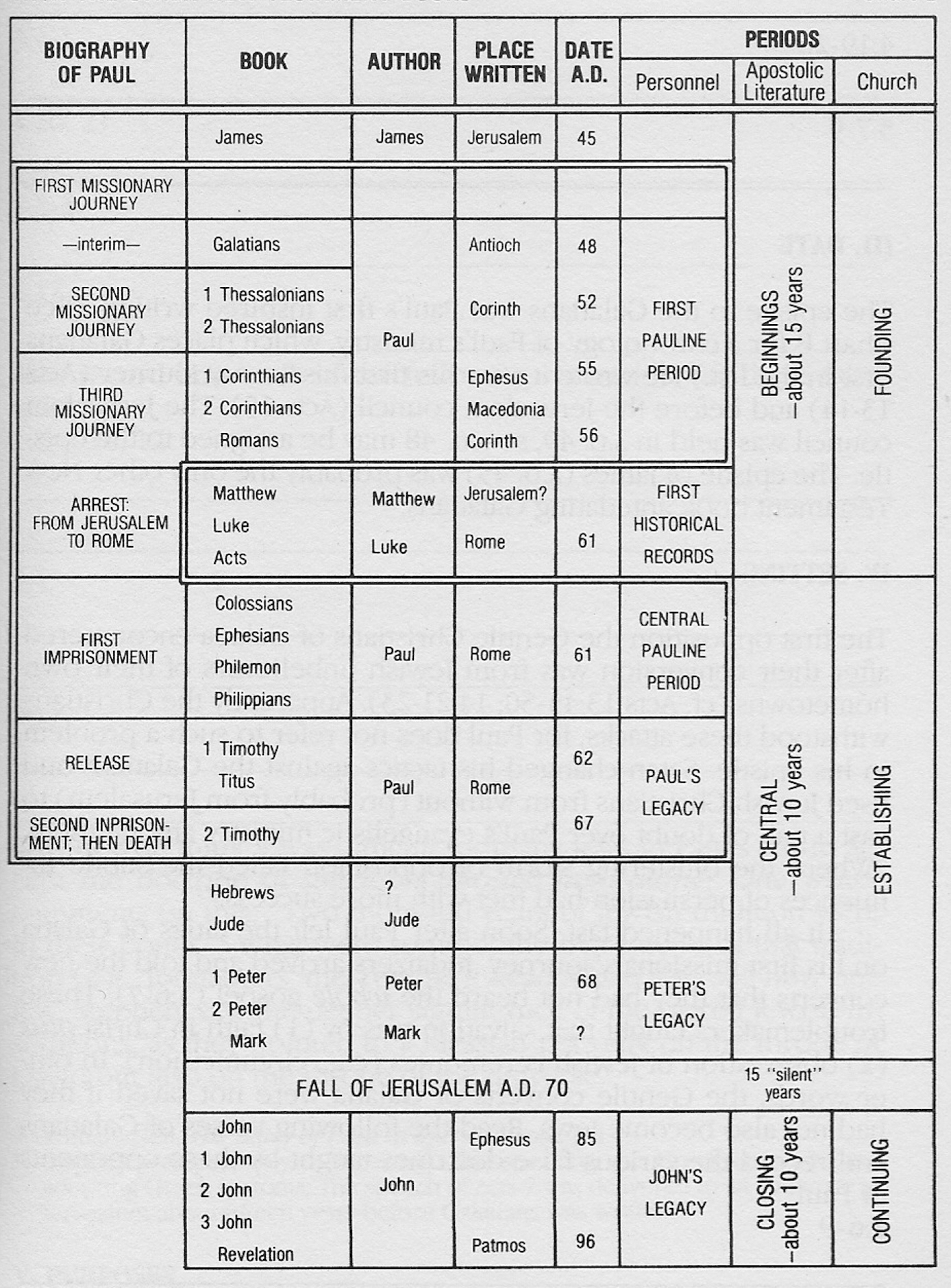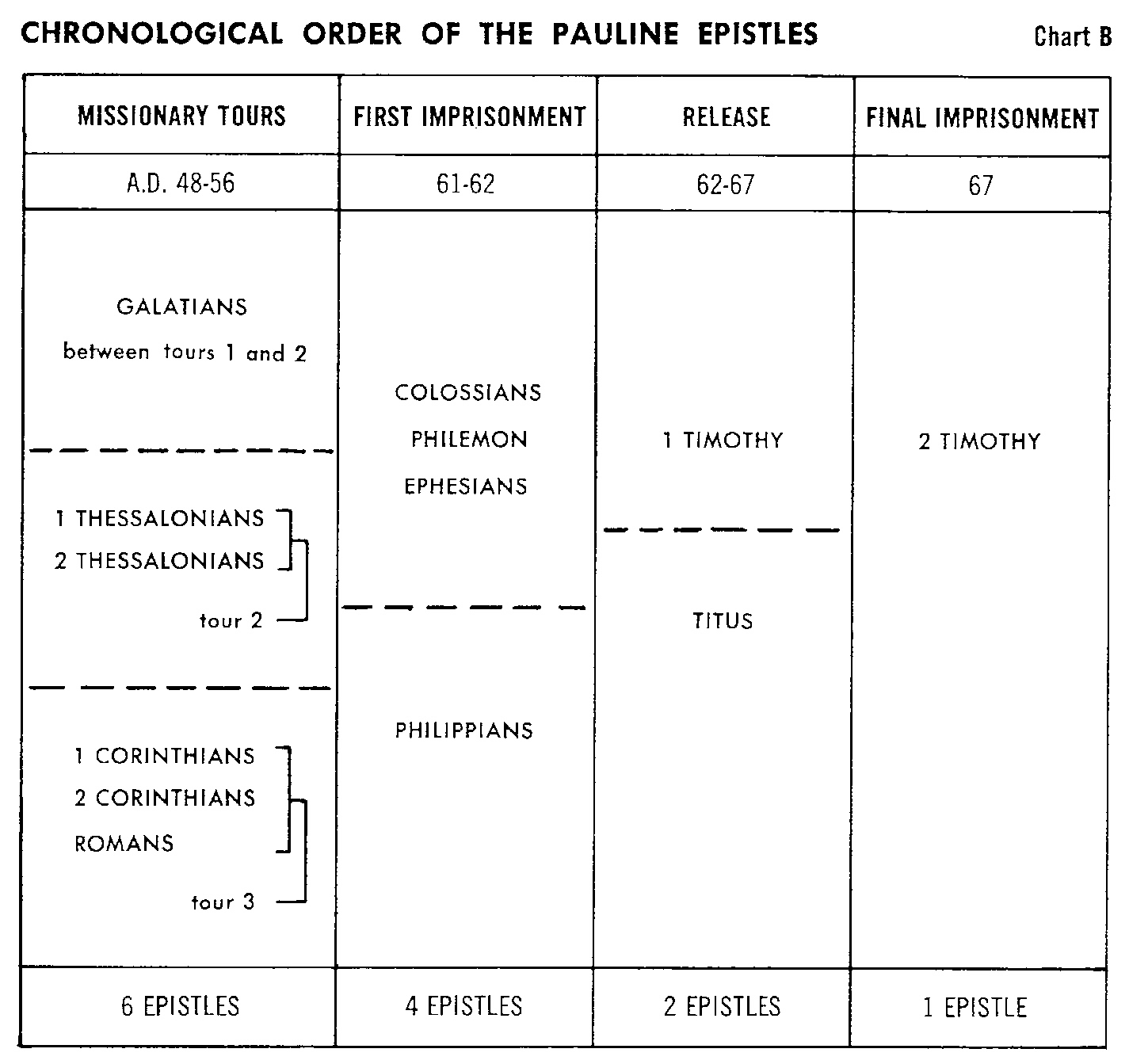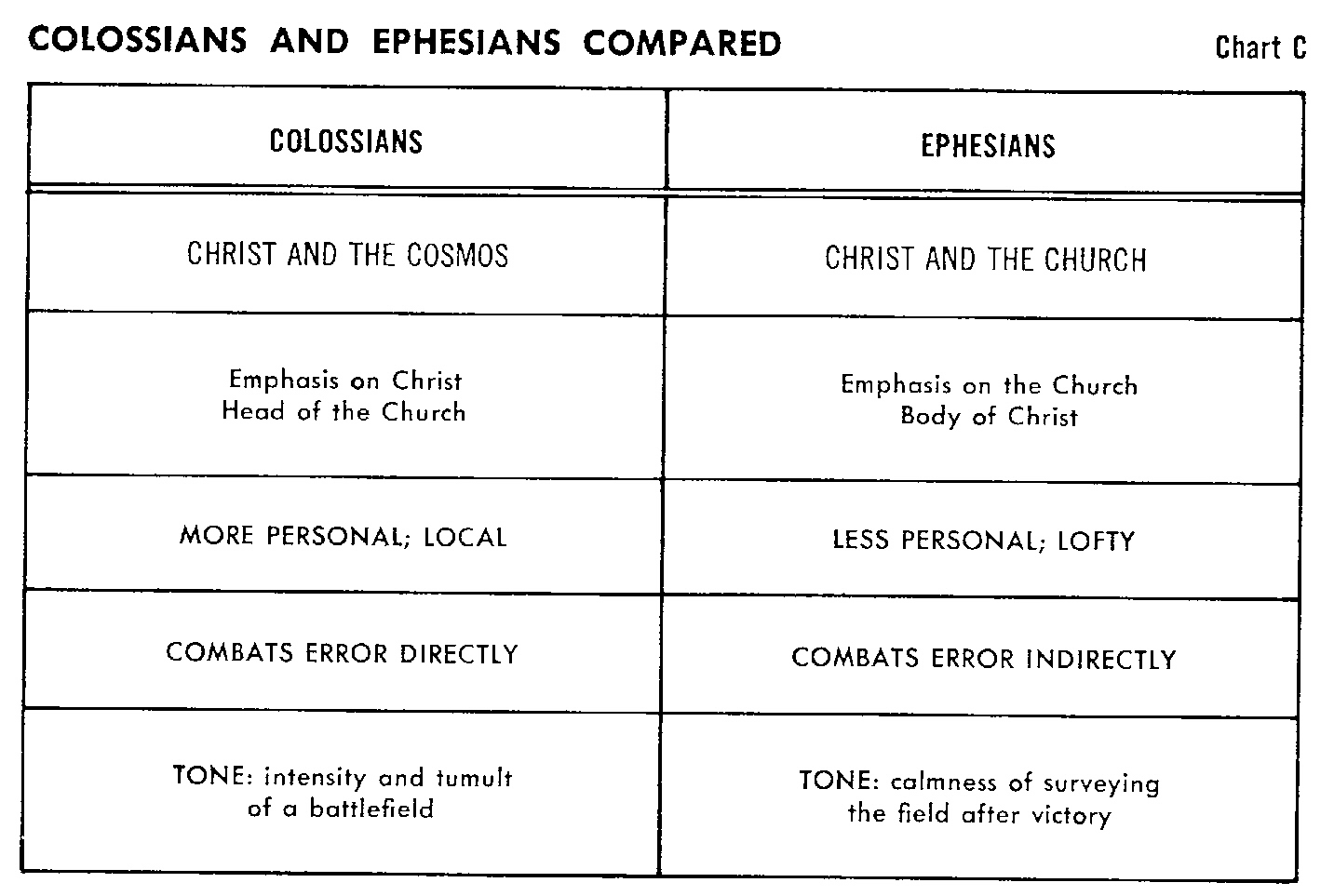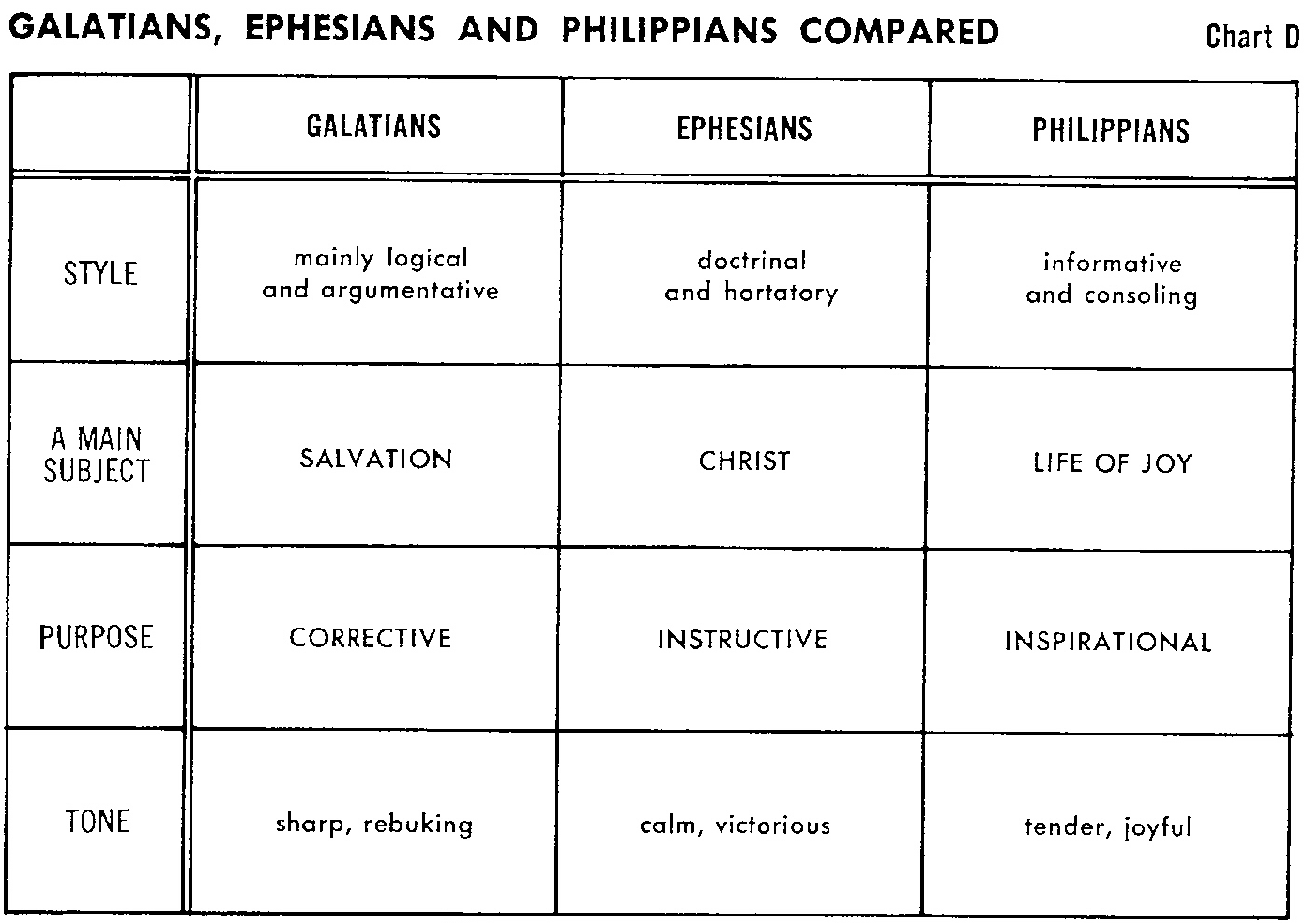INTRODUCTION TO EPHESIANS
Irvine L. Jensen
The Moody Bible Institution of Chicago
copyright © 1973
Used by permission.
QUESTIONS TO STUDY ONE.
OUTLINE
MAP OF PAUL'S FIRST AND SECOND MISSIONARY TRIPS
MAP OF PAUL'S THIRD MISSIONARY TRIP

Before analyzing the text of any book of the Bible, it is well to learn the historical background. Also, it is best to make a mountain top view of its general contents.
Read Acts 19:17-20 for one glimpse of this group before and after their conversion (A.D. 55). Little did the Christians know then that the bonfire of their heathen books, worth over ten thousand dollars, would bring forth out of its ashes a spiritual gold mine-one short book of Ephesians-just six years later.
The background of Paul's letter to the Ephesians needs studying to help us better appreciate and understand its message as we study the Bible text. This follows the usual order of study, which is:
1) viewing the background
2) surveying the whole book
3) analyzing the parts.
- TIMELINE (by Stephen Ricker)
- Paul was arrested in Jerusalem (57 A.D., Acts 21:33)
- Paul is transferred to Rome to stand at trial before Caesar (59-60 A.D., Acts 25:10-28:16)
- Paul awaits for trial in Rome under house arrest. Acts is penned by Luke who was with Paul. (60-61 A.D. Acts 28:17 to end)
- Paul underwent his first Roman imprisonment during which he wrote Colossians, Philippians, Philemon, and this letter. (61-62 A.D.)
- Paul was released from prison. (between 62 and 64 A.D.)
- AUTHOR
Twice in the text of Ephesians, Paul is identified as the author. Read 1:1 and 3:1. Internal evidences of style and content, as well as the external witness of tradition, support this observation.
Paul was around sixty-five years of age when he wrote the letter. He referred to himself as an "aged man" when he wrote to Philemon at this same time.
If you have not recently studied the life and ministry of this great apostle, you may want to refer to a brief treatment of Paul's biography in a Bible dictionary or encyclopedia.
- DESTINATION
- Main Views
There are two main views as to the original destination of Paul's letter:
- The church of Ephesus. This view is supported by the reading of 1: 1, and by the traditional title assigned the epistle by the early church Fathers: "To Ephesians" (Greek, Pros Ephesious). Also, such verses as 4:17 and 6:21-22 point to a specific church as being addressed, whatever that church was.
- A circuit of various unspecified churches. This view is based mainly on the fact that some important ancient manuscripts omit the phrase "at Ephesus" (Greek, en epheso) in 1: * Also, the epistle as a whole lacks Paul's usual personal greetings and so appears to be a circular letter!. **
Each of the above views has its strengths and weaknesses. Perhaps the answer is found in combining the two views. In the words of one writer, "The epistle was written to the Ephesians and addressed to them, but... the Apostle intentionally cast it into a form which would make it suitable to the Christians in the neighboring churches and intended that it should be communicated to them.***
See maps links above for the location of churches in the vicinity of Ephesus who would have read Paul's letter sooner or later. Compare these with the locations of the churches to whom John sent Revelation (Rev 1:11). Read Acts 19:8-10; 20:31 for references to Paul's three-year ministry to people living in Ephesus and the regions round about.
- The City of Ephesus
The Christians living in and around Ephesus to whom Paul wrote this sublime epistle were cosmopolitan-oriented, and well informed about world affairs. This is because of the city's strategic location. Ephesus was recognized as the "first" city of the province of Asia, even though Pergamum, ninety miles to the north, was its capital. Try to imagine some of the native characteristics of the congregation at Ephesus from these brief notes about the city:
- Commerce. Ephesus was one of the three leaders of international trade, the other two being Alexandria of Egypt and Antioch of Syria. Note on Chart A the city's trade-oriented location.
- Arts and sciences. The city was a haven for philosophers, poets, artists and orators. Corinth, across the Aegean Sea, was one of its rivals in those disciplines.
- Religion. The worship of Diana (Greek, Artemis) was the dominant religion of this area. The Temple of Diana was world famous. Read Acts 19:23-34, noting among other things from the passage that Demetrius boasted that "all Asia and the world" worshiped Diana (19:27). Many of the Ephesians also identified with the imperial cult of Augustus and with various forms of magic (cf. Acts 19:13- 19; Eph 6:12). When you study Ephesians try to recall from time to time that its original readers were converts from the darkness of these idolatries.
- The Church at Ephesus
Read the following passages for what they reveal concerning the Ephesian church. Look for such things as first converts, leaders, and organizational growth. Record your findings.
- Pentecost converts from Asia
A.D. 30-Acts 2:9
- Before Paul's extended campaign at Ephesus
A.D. 52-Acts 18:18-21
18:24-26
- During the extended campaign
A.D. 52-56--Acts 19
Acts 20:17-27 (Paul recalling the past)
- Charge to the Ephesian elders
A.D. 55-56--Acts 20:28-38
- Charge to Timothy
A.D. 64-1 Timothy 1:3
Most of the Ephesian congregation were Gentile converts, though the number of Jewish Christians was not small. Note the two references to "Jews and Greeks" in Acts 19:10, 17. Since their conversion took place in A.D. 55, and Ephesians was written in A.D. 61, the congregation was relatively young in the Lord when they read Paul's letter for the first time. The church itself served as a "mother church" to the others of the province. By the time the apostle John became a spiritual shepherd of the Asian Christians toward the end of the first century, the Ephesian church was regarded as the "headquarters" of Christian missions, succeeding Antioch of Syria (which had succeeded Jerusalem). Observe in Revelation 1: 11 the location of the name Ephesus in the list of the seven churches. Does this suggest something to you?
- DATE AND PLACE WRITTEN
A date assigned to the writing of Ephesians is A.D. 61. This is based on Paul's writing the epistle during his first imprisonment in Rome, which lasted at least two years (A.D. 61-62). At this time he also wrote Colossians, Philemon and Philippians. The four are generally referred to as the prison epistles. Read Acts 28:30-31. Were circumstances favorable to Paul to meditate, study, and write during this imprisonment? John Bunyan wrote the classic Pilgrim's Progress while in prison. Have you read of other "prison masterpieces"? How do you account for such a phenomenon?
Chart B shows the four periods of Paul's public ministry during which he wrote epistles. Each list of books is shown in the chronological order of writing.**** Colossians, Ephesians and Philemon are grouped together, since these were written and dispatched at the same time by the same messengers (read Eph 6:21-22; Col 4:7-9; Philemon 12).

For Paul's references in the prison epistles to his imprisonment, read the following passages in the four epistles:
- Colossians 4:3, 18
- Ephesians 3:1; 4:1; 6:20
- Philemon 10, 13, (23)
- Philippians 1:7, 13
Also read the following verses that indicate Paul was expecting release from his first imprisonment in Rome:
- Philippians 1: 19-26 and Philemon 22
- OCCASION AND PURPOSE OF THE EPISTLE
Ephesians does not give a clue to any specific problem ill the Ephesian church to which the epistle may have been directed. By "specific problem" is meant such things as heresy (e.g., Colossians); internal strife (1 Corinthians); false accusations (2 Corinthians); false doctrine (Galatians). But when Paul wrote Ephesians he must have still been thinking of such evils as doctrinal heresy threatening the neighboring church at Colosse, which he specifically referred to in his letter to the Colossians. No church is ever immune to doctrinal defilement, so it could be that the apostle's positive teachings in Ephesus on the pure knowledge of Christ were directed at the same kinds of problems vexing the Colossian church. Also, the Christians at Colosse would eventually be reading Ephesians, as it made the rounds of the churches of Asia. Hiebert writes on this:
Judging from its close relation to Colossians, it appears that the conflict which caused the writing of Colossians likewise called forth this epistle. The Colossian conflict revealed to Paul the need for a fuller statement of God's program for the universe as it centers in Christ in His relationship to the Church.*****
No doubt there were individual problems in the Ephesian church. But the basic need of the young Christians there was to grow spiritually in the Lord, by (1) an increasing awareness of their relationship to Him and His ministry to them through the Spirit, and (2) the day-today experience of walking in that light. Paul was inspired to address this epistle to that basic need. And it can be said without qualification that now almost two thousand years later the letter still serves the same function for the children of God.
- CONTENTS
Much of our survey study of Lesson 2 will concentrate on the contents of Ephesians, especially main contents. A preview of some of those things is given below.
- Doctrine
- Salvation: as a deliverance from, and deliverance unto
- Union with Christ: an inscrutable yet real relationship
- The church universal: as the body of Christ, who is its Head
- Holy Spirit: the source of every blessing and power in the Christian life
- Will and work of God: for man's benefit and God's glory
- Prayer and Praise
Two notable prayers appear at 1:15-23 and 3:14-21. The opening passage 1:3-14 has been called a "Hymn of Grace." The epistle has been well described as one of "instruction passing into prayer, a creed soaring into an impassioned psalm."
- Practice
At least half the epistle is devoted to the practical walk of the believer in Christ. The Christian's walking (4:1) and standing (6:11) are based on his sitting (2:6). His life in Christ (chaps. ~) is drawn from his heritage in Christ (chaps. 1-3). The armor passage of 6:10-17 is a classic Scripture portion describing the weaponry of the Christian's spiritual warfare.
- General Characteristics
Ephesians is a book of grand superlatives. It is the sublimest of all of Paul's epistles, for which it has been called "The Grand Canyon of Scripture." There are very few personal notes and biographical references and, as noted earlier, controversies and problems are not discussed here. Paul is not thus ignoring the practical mundane issues, as though they were unimportant. (It has already been noted that at least half the epistle is practical in purpose.) Rather, the apostle has a vision of the heavenly realm, and in the quiet and calm of his imprisonment he is inspired by the Spirit to share this with his readers.****** Philip Schaff describes this aspect of the epistle:
It certainly is the most spiritual and devout, composed in an exalted and transcendent state of mind, where theology rises into worship, and meditation into oration. It is the Epistle of the Heavenlies... The aged apostle soared high above all earthly things to the invisible and eternal realities in heaven. From his gloomy confinement he ascended for a season to the mount of transfiguration. The prisoner of Christ, chained to a heathen soldier, was transformed into a conqueror, clad in the panoply of God, and singing a paean of victory.*******
The distinctive language and style of Ephesians reflects the richness and depth of its message. Someone has observed that the letter contains forty-two words (e.g., "obtained an inheritance," 1:11) not found in any other New Testament book, and forty-three not used by Paul in his other writings. One of the prominent features of Paul's style in Ephesians is its long sentences, described thus by one writer: "The sentences flow on as it were in the full strong tide, wave after wave, of an immense and impetuous sea, swayed by a powerful wind, and brightened and sparkling with the golden rays of a rising sun." This suggests something of the excitement and inspiration in store for you as you move into the analytical studies of the Bible text. As one Bible student has well said, "If we persevere with our study of Paul, we shall soon discover that we are sitting at the feet of one who, more than any other human being, has got 'far ben [within]' into the wonders and the glories of that 'open secret of God' which is 'Christ in you, the hope of glory' (Col 2:2 and 1:27)".********
- RELATION TO OTHER NEW TESTAMENT BOOKS
- Prison Epistles
We have already seen that the four prison epistlesEphesians, Philippians, Colossians and Philemon-were written about the same time. This would account for at least some of the similarities of these books. Ephesians, Philippians and Colossians were written to local churches of those cities; Philemon, although written particularly to a personal friend of Paul, was also addressed to the church meeting in Philemon's house (Philemon 2; cf. Colossians 4:15).
- Ephesians and Colossians
Ephesians and Colossians have been called twin epistles because of their many likenesses. Phrases of 78 of Ephesians' 155 verses are very similar to phrases in Colossians. This is explained by the fact that both epistles were written with the same general purpose: to show the relationship between Christ and His church as assurance and correction to young Christians growing and maturing in the Lord.
But the two epistles are far from being identical twins. Some differences are shown on Chart C.

- Ephesians, Galatians, and Philippians
Chart D shows some comparisons of Ephesians, Galatians, and Philippians.

As you conclude your overview of Ephesians, ponder over the key verses: 1:17-23; 2:4-10; 2:19-22; 3:14-21; 6:10-17.
* Main examples are the two primary uncials, Sinaiticus and Vaticanus (4th century), and the Chester Beatty papyri (3d century)
** An exception is 6:2l.
*** D. Edmond Hiehert, An Introduction to the Pauline Epistles, p. 266.
**** Authorities differ in assigning dates to some of Paul's epistles. Hebrews. an anonymous letter, is not included in this list.
***** Hiebert, p. 266.
****** The word heaven(s) appears four times, and heavenly places (or heaven Hes) four times, in Ephesians.
******* Philip Schaff, History of the Christian Church, (New York: Scribner, 1910), 1:780
******** Alexander Ross, "The Pauline Epistles" in The New Bible Commentary, p. 69.
STUDY 1 QUESTIONS
STUDY 1 COMMENTS
|